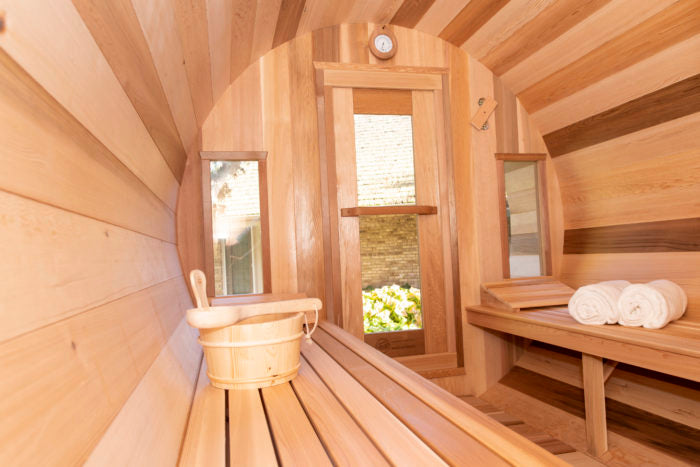3 Simple Techniques For Traditional Sauna
Wiki Article
The 10-Minute Rule for Traditional Sauna
Table of ContentsRumored Buzz on Traditional SaunaEverything about Traditional SaunaTraditional Sauna Can Be Fun For Everyone7 Simple Techniques For Traditional Sauna
The majority of the weight lost in a sauna is water loss and is re-gained upon rehydrating. Nonetheless, undeniably sauna can be a crucial part of a healthy and balanced weight reduction program. To take a look at the differences in between traditional and IR saunas, I will divide these into proven, academic, and made differences.Thus, the hottest factor in the saunawhich goes to the ceiling straight above the sauna heateris typically between 185 and 190 F. Traditional Sauna. Claims that a conventional sauna goes beyond 200 F is just not true and not relevant for electric saunas offered in the United States. The temperature for a far-infrared sauna is normally set in between 120 and 140 F; nevertheless, unlike the typical sauna, the objective in and IR room is not to accomplish a heat
Since of this, the temperature distinction is practically pointless, given that excessive sweating causes both sauna types, but the approach of warming the body is various. In an IR sauna the bather will really feel hot and will sweat a lot, yet at much lower temperatures. Thus, if the objective is to spend longer amount of times in the sauna, the IR sauna is a good option.

Traditional Sauna Fundamentals Explained
When the heat is attained, the components cycle on and off to maintain the high temperature level. Many standard sauna customers delight in putting water over the rocks to create steam to increase sauna moisture levels. The benefits of putting water over the rocks include: making the area more comfy, dampening the nasal passages, and enabling the use of aromatherapy by blending essential oils with the water.In a far-infrared sauna, the warm waves pass through the body to efficiently heat the body and increase the body core temperature level. To attain this raised temperature level, Far-infrared emitters develop infrared power which is close to the exact same wavelength as that which the body naturally emitsoften referred to as the "Vital Range" of 7 to 14 microns), so the power is well obtained by the body.
When the power goes into the body, it causes the body temperature to increase and inevitably causes sweating. In an infrared sauna it's crucial for the emitters/heaters to stay on nearly regularly. Given that there is no mass of rocks to preserve go right here warmth, the sauna will certainly cool down if the emitters shut down.
As discussed above, the sauna bather in an infrared space intends to position himself in front of operating emitters to get optimal gain from the warmth. The home heating time for the 2 spaces can be very various, depending on how the areas are utilized. For a standard sauna, a bather ought to allow 30-40 mins for the area to attain a wanted temperature and to effectively pre-heat the rocks.
The Ultimate Guide To Traditional Sauna
A well created sauna will generally accomplish a temperature level of 150-160 F in about 30-40 mins. For hotter temperature levels, the area may require to heat for a longer period.To some, 15 mins was "wasted" while the infrared energy warmed the wood panels instead of heating up a body, while others locate a pre-heated area to be more comfy and think a raised starting temperature is essential to begin sweating. The size of advised usage for each and every area is approximately the same (10-15 minutes per session); however, due to the lower air temperatures and the ability to feel the impacts of infrared warm much faster than a traditional sauna, it is not uncommon for a person to invest a total of 20-30 minutes in an infrared sauna.
Standard saunas have a tendency to be larger (thus use even more power) than infrared saunas, although typical saunas are certainly available in one and two person sizes. For a two-person standard sauna, 5x6 or 5x7 size is most prominent. The top bench can easily seat two or three people and is also long enough to rest throughout the sauna session.


The average price per kWH of electrical power in the united state is about $0.11, so a 4.5 kW heater will certainly set you back about $.50 to compete one i loved this hour, if the heating unit runs continually for one hour. Normally a sauna heater will certainly run for 75% of the initial hour and 50% of subsequent hours on considering that his response the elements cycle once the set temperature level is achieved.
Some Ideas on Traditional Sauna You Need To Know
A 2 individual far-infrared area is typically literally smaller sized than a traditional sauna, often regarding 4' x 4' or smaller sized. The IR home heating system is typically 1.5-1.7 kW using a 120 volt 15 amp plug-in solution. Given that the area can be made use of quicker than a sauna area, we will certainly assume the area is utilized for to of an hour consisting of heat up time.Finally, there is a hardly ever gone over difference in the social experience in between both spaces. While our culture has lost some of the social advantage of the typical sauna experience, it can be really socially fulfilling. From family members time in the sauna, to heart-felt discussions with loved ones, to sauna partiesthe standard sauna experience can result in intimate socializing.
The majority of greater end infrared spaces include colored light treatment, audio systems and full-glass fronts.
Report this wiki page